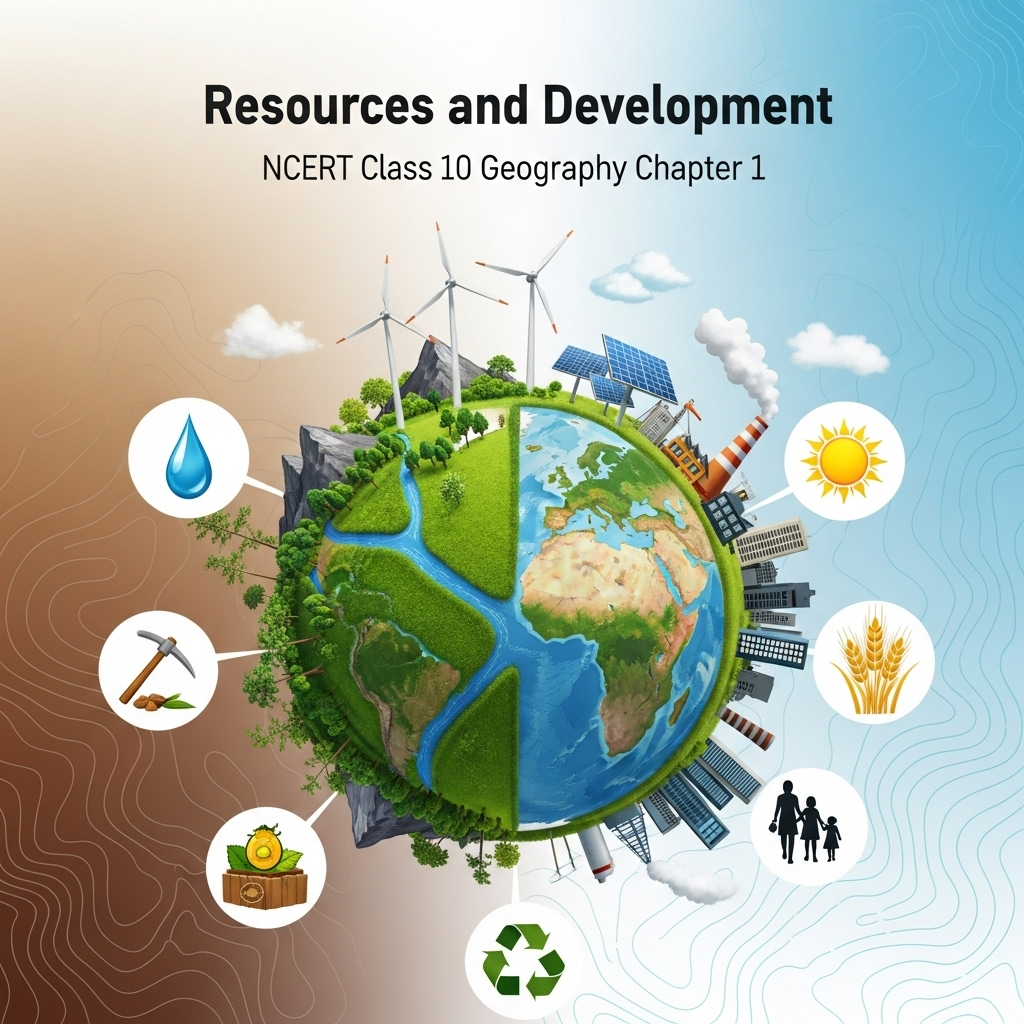Complete Solutions and Summary of Resources and Development – NCERT Class 10, Geography, Chapter 1 – Summary, Questions, Answers, Extra Questions
Detailed summary and explanation of Chapter 1 ‘Resources and Development’ covering definition and types of resources, resource planning, land resources, land utilization, land degradation, soil resources, soil types and conservation, with all question answers, activities, and extra questions from NCERT Class X Geography.
Updated: 2 months ago
Categories: NCERT, Class X, Geography, Summary, Extra Questions, Resources, Resource Planning, Land Degradation, Soil, Soil Conservation, Chapter 1

Resources and Development
Chapter 1: Geography - Complete Study Guide | NCERT Class 10 Notes & Questions 2025
Comprehensive Chapter Summary - Resources and Development Class 10 NCERT
Overview
- Chapter Purpose: Explains resources as everything in environment satisfying needs if technologically accessible, economically feasible, culturally acceptable. Involves interaction between nature, technology, institutions. Humans transform materials into resources. Fig. 1.1: Interdependent relationship. Not free gifts; function of human activities. Key Insight: Resources vital for survival, quality life; indiscriminate use leads to depletion, inequality, ecological crises. Sustainable development essential.
- Classification of Resources: (a) Origin: Biotic (living, e.g., flora/fauna), Abiotic (non-living, e.g., rocks/minerals). (b) Exhaustibility: Renewable (replenished, e.g., solar/wind), Non-renewable (finite, e.g., fossil fuels). (c) Ownership: Individual (private land), Community (village commons), National (minerals), International (ocean beyond EEZ). (d) Development Status: Potential (undeveloped, e.g., Rajasthan wind), Developed (utilized), Stock (known but not usable, e.g., water hydrogen), Reserves (subset of stock, extractable). Fig. 1.2: Classification flowchart.
- Expanded Relevance 2025: With global warming, focus on sustainable use; India’s resource planning addresses diversity/shortages. Update: Link to SDGs, Agenda 21.
- Exam Tip: Use figures for classification; distinguish renewable/non-renewable with examples.
- Broader Implications: Resources drive development but overexploitation causes crises; equitable distribution key for peace.
Development of Resources
- Problems: Depletion for greed, Accumulation in few hands (rich/poor divide), Ecological crises (global warming, ozone depletion, pollution, land degradation).
- Sustainable Development: Development without damaging environment, not compromising future needs. Rio Earth Summit 1992: 100+ heads signed Climate Change/Biodiversity declarations, adopted Agenda 21 for 21st-century sustainability.
- Agenda 21: UNCED declaration at Rio for global cooperation on environment, poverty, disease; local governments draw own Agenda 21.
Resource Planning
- Need in India: Diversity in resources; some regions rich (e.g., Jharkhand minerals) but deficient others (e.g., Ladakh water/infrastructure). Balanced planning at national/state/regional/local levels.
- Process: (i) Identification/inventory via surveying/mapping/estimation. (ii) Planning structure with technology/skills/institutions. (iii) Matching with national plans. India’s efforts from First Five Year Plan.
- Factors for Development: Availability alone insufficient; need technology, human quality, historical experiences. Colonization example: Rich colonies exploited due to invaders’ tech superiority.
- Conservation: Irrational use leads to problems; Gandhiji: Enough for need, not greed; against mass production. Club of Rome 1968, Schumacher “Small is Beautiful” 1974, Brundtland Report 1987 (“Our Common Future”).
Land Resources
- Importance: Supports vegetation, wildlife, human/economic activities; finite, use carefully. Relief: Plains (43%, agriculture/industry), Mountains (30%, perennial rivers/tourism/ecology), Plateaus (27%, minerals/fuels/forests). Fig. 1.3: Land under relief.
- Land Utilization: Forests; Not available (barren/waste, non-agri uses); Uncultivated (pastures, tree crops, culturable waste); Fallow (current/other); Net Sown Area (NSA), Gross Cropped Area (GCA).
- Land Use Pattern: 3.28 million sq km total; data 93% (NE states/J&K incomplete). NSA ~54% incl. culturable waste. Varies: Punjab/Haryana >80%, Arunachal <10%. Forest <33% desired (NFP 1952). Pastures decreased; consequences on cattle. Fig. 1.4: Pie charts 1960-61 vs 2019-20; marginal changes in NSA/forests.
Land Degradation and Conservation
- Causes: Deforestation, overgrazing (Gujarat/Rajasthan/MP/Maharashtra), Mining (Jharkhand/Chhattisgarh/MP/Odisha), Overirrigation (Punjab/Haryana/UP - salinity/alkalinity), Mineral processing dust, Industrial effluents.
- Measures: Afforestation, grazing management, shelter belts (arid areas), thorny bushes for sand dunes, mining control, effluent treatment.
Soil as a Resource
- Formation: Relief, parent rock, climate, vegetation, time; forces like temperature, water, wind, glaciers, decomposers; chemical/organic changes. Consists humus/inorganics. Fig. 1.5: Soil Profile (topsoil, subsoil, substratum, bedrock).
- Classification: Alluvial (fertile, northern plains/deltas; Bangar/Khadar); Black (regur, cotton; Deccan trap); Red/Yellow (iron diffusion; low rain areas); Laterite (leaching; acidic, tea/coffee); Arid (sandy/saline; irrigation cultivable); Forest (hilly, acidic/low humus).
- Soil Erosion: Denudation/washing; balance disturbed by human (deforestation/overgrazing) or natural (wind/water/glacier). Types: Gully (channels/ravines), Sheet (topsoil wash), Wind (loose soil). Defective farming worsens.
- Conservation: Contour ploughing, Terrace farming, Strip cropping, Shelter belts.
SEO Note: Why This Guide?
Top-ranked for 'Resources and Development Class 10 notes 2025'—free, with 60 Q&A from PDF, quizzes. Integrates resource insights.
Key Themes
- Resource Variations: Renewable vs non-renewable.
- Details: Classifications, planning, land/soil types. Fig. 1.8: Major Soil Types map.
- Conservation Links: Sustainable development, Gandhian philosophy.
- Critical Thinking: Why degradation? How planning helps? Tech role.
Cases for Exams
Use Fig. 1.4 for land use changes; discuss soil types with map; analyze Agenda 21 objectives.
Exercises Summary
- Focus: Expanded to 60 Q&A from PDF: 20 short (2M), 20 medium (4M), 20 long (8M) based on NCERT exercises + similar.
- Project Idea: Puzzle for resources; map marking of soil types, land use.
Group Discussions
No forum posts available.


